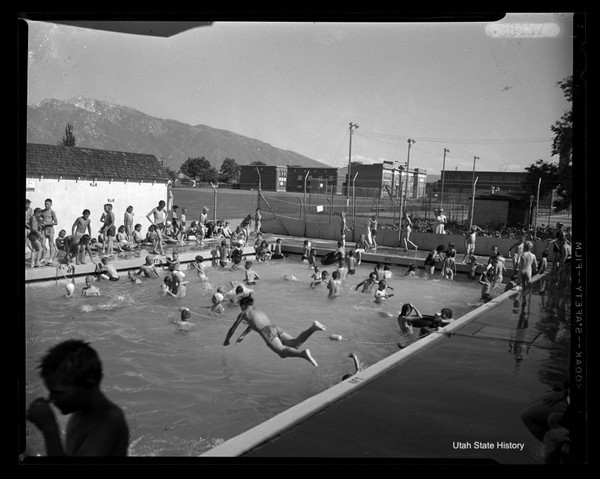Dublin Core
Title
Description
After World War II, the United States rallied in another war against a new kind of enemy: the poliomyelitis virus, also known as polio. The disease causes fever, difficulty breathing, and in extreme cases, paralysis and death. When contracted, polio causes paralysis in about 30% of its victims. Although it was endemic for centuries, long term effects of polio slowly took the life of the nation’s president -- Franklin Delano Roosevelt -- causing the public to rally to protect American children from the disease. One aspect of public life, however, was thrown into uncertainty -- were public pools an avenue of polio treatment or venues for its transmission?
Transmission of polio is especially rampant in summer, but officials remained unclear about how it spread. In the 1940s, some Utah towns -- like Provo -- closed their pool entirely in an effort to curtail the spread of the disease. As an alternative, Moab officials restricted each child to 20 minutes of daily swimming. Although we now know polio is primarily transmitted through contaminated food and water, officials at the time also cautioned people to dispose of garbage and keep windows and screens tightly closed.
Although spread of polio could happen through contaminated water, its treatment could also rely on water. Hydro-therapy at places like the Wasatch Warm Springs on Salt Lake City’s Beck Street provided relief, although this was a sort of folk remedy. But even the Warm Springs had to close eventually because, as a mineral spring, it was unable to use chlorine to regulate bacteria levels and kill diseases such as polio.
In Utah, like much of the United States, the polio virus has been eradicated thanks to vaccine technology. But for a time, the future of polio victims was uncertain, and the role of water added to the ambiguity. Was it spreading the sickness, or was the physical relief it provided necessary for ailing children? Ultimately, strict chlorine sanitation rules around pools ensured the virus would be inactivated in the water, and fundraising across the US helped pay for the discovery of a vaccine. In time, Utahns could enjoy swimming pools again without thinking of possible infection.
Creator
Source
_______________
See Alexandra Linn, “Polio and Swimming Pools: Historical Connections,” The History of Vaccines, accessed February 2022; Michael McClane, “Past and Present Collide at Warm Springs,” Catalyst Magazine, accessed February 2022; “Swimming to be Limited,” Times Independent, August 8, 1946; “Provo Officials Act to Halt Spread of Polio,” Salt Lake Telegram, July 22, 1943; Luke Peterson, “Kids and COVID-19,” Salt Lake Tribune, September 17, 2021.

